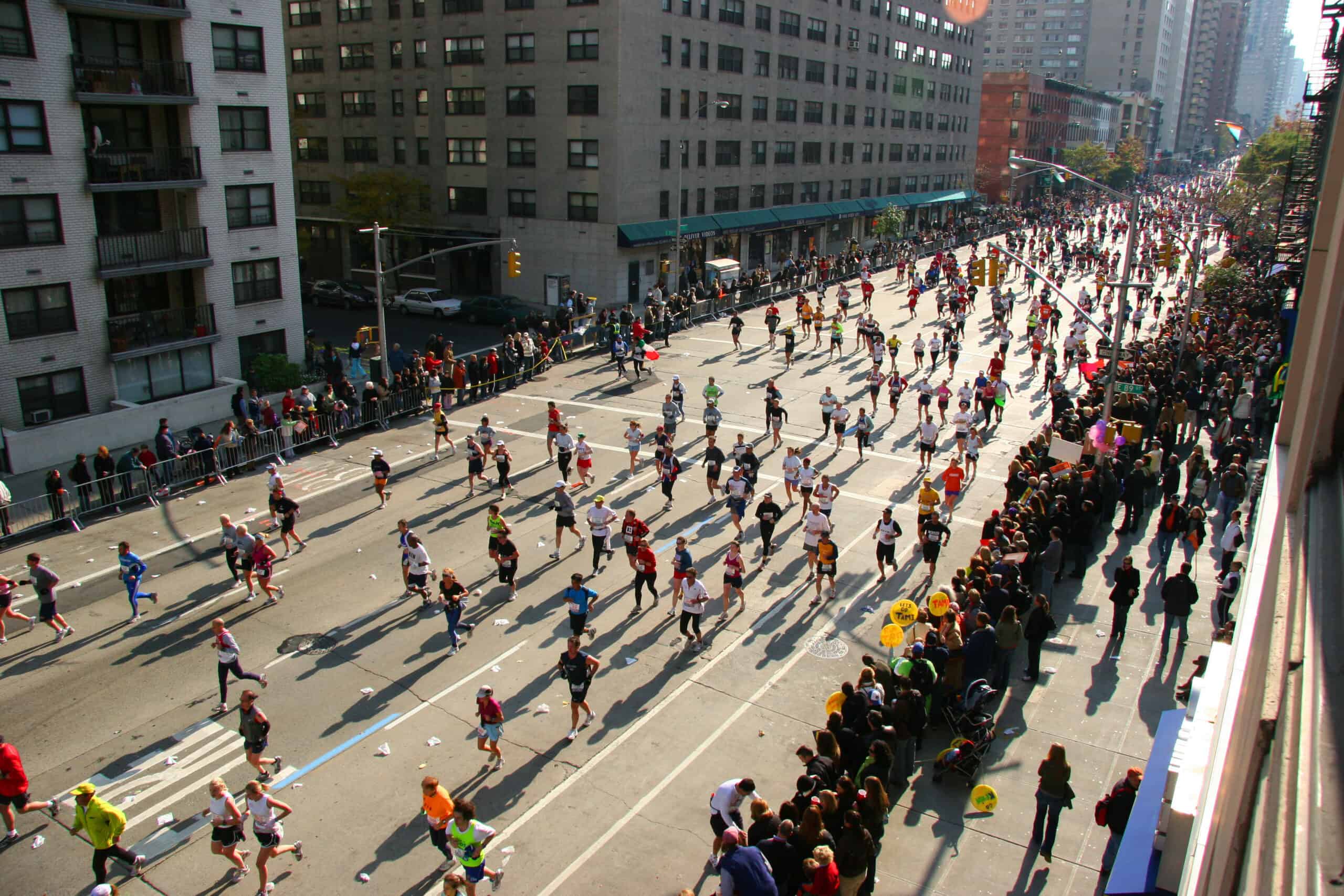Forget the myth that you have to run every mile non-stop to succeed in a half marathon, or any race for that matter. The Run-Walk Half Marathon Training Method is a smart and less-intimidating approach to increasing your mileage for anyone just starting out, making a comeback, or even a seasoned pro chasing a personal best.
Run-walking not only takes it easy on your body and mind but also spices up your training routine, cranking up your endurance without as high of a risk of injuries.
The Run-Walk-Run Method was pioneered by running coach and Olympian Jeff Galloway.
It’s been a game-changer for runners of all levels, offering a blend of running and walking intervals to enhance sustainable performance, reduce the risk of injury, and make the daunting half marathon race more achievable.
Whether you’re a first-timer runner with sights set on the half marathon or a running veteran looking to optimize your training, using a run-walk training plan has proven benefits to help you run your best.
Related: How To Train For A Half Marathon
Why Trust Us?
For nearly half a decade, Ali Nolan has written about running ad an Editor at Runner’s World. In 2021, Ali authored Master The Marathon: The Ultimate Training Guide for Women with extensive coverage and training plans on the 26.2 mile distance with a forward by Olympian Des Linden.

What Is the Run-Walk-Run Method?
The Run-Walk-Run Method is a training approach where your workouts consist of intervals that switch between running and brisk walking to slowly build stamina over time.
Here’s how it works:
- Run-walk plans give you a set time to run, followed by a set time to walk. For example, you may start out running for 30 seconds followed by 1 minute of walking.
- During the running intervals, you run at a comfortable pace that is just challenging enough to elevate your heart rate but not so intense that you can’t sustain it for the duration of the set interval time. (We’ll talk more about how to find your ideal training pace below.)
- The walking intervals follow the running segments, allowing the heart rate to decrease and providing active recovery.
- You repeat the run-walk pattern until you hit the goal time for that day’s workout.
Over time, you’ll be able to run for a longer amount of time, and most run-walk plans gradually increase the running intervals and decrease the walking intervals over time.
The gentle progression helps the body adapt to the demands of running and improves cardiovascular fitness. Eventually, many runners can run continuously without many walking breaks.
How It Started
Galloway designed the program in 1973 as a response to his own running journey and his observations about the running community. He wanted to prevent injuries, enhance recovery, and make long distance running — particularly half marathons and marathons — more accessible to beginners. He is so synonymous with the technique that some runners refer to run-walking as “Jeffing,” after his first name.
As distance running became more popular with the general population, running pros took notice of the success novice runners experienced while using a run-walk plan.
Nowadays, many running coaches use the Run-Walk-Run Method to help runners build a base safely. It’s also employed in many beginner programs including Couch to 5K and Couch to Half Marathon.
Who the Run-Walk-Run Method is Right For
Run-walking is often associated with beginners, but many other runners benefit from using this type of program. Consider a run-walk training plan for your next or first half marathon if you:
- Have trouble controlling your pace: Advanced runners have turned to run-walk plans for half marathon training and racing to help them dial in their pace. Maintaining a consistent overall pace is easier for some when there are short intervals of rest.
- Are returning from injury: Runners returning from injuries or medical conditions also benefit from the steady progression of run-walking. Jeff Galloway himself experienced a heart attack and started with 5 seconds of running, and 30 seconds of walking.
- Feel like you’ve plateaued: Runners who’ve been in the game for a while might be unable to beat their best finish times or feel their best in training or racing. Run-walking can work like a Fartlek. Experimenting with freeform intervals that include walking can help rev your aerobic engine, and playing around with running and walking can help you mentally overcome the feeling of being stuck.
- Struggle to run for more than 5 minutes at a time: If you opt to use a run-walk plan, you don’t have to run 5 minutes at a time at any point, but you’ll gradually gain enough aerobic capacity that you will be able to run for that amount of time – or much longer if you wanted to. Many beginners will start by running 30-second intervals, followed by walking, and repeating the pattern for 30 minutes. Eventually, those running intervals will increase in duration. Even though you’re not running every step, you’re building your aerobic capacity and endurance.
Can I Use the Run-Walk Strategy for Half Marathon Training?
Most definitely. Half-marathon training can be overwhelming; If you’re new to 13.1 miles, this training schedule might be the first time you’re seeing double-digit long runs. No matter what level you’re at, your body will be tested as you increase your weekly mileage.
The run-walk approach can help both your mind and body master the training at hand. Namely, it helps:
Build your aerobic capacity up slowly
By integrating walking intervals into your routine, your body gets a chance to recover more, enabling you to extend your running sessions without becoming exhausted and without sacrificing running form.
Ease your body into the physical demands of running
Some 50% of recreational runners have had a running-related injury, according to multiple studies. Physical therapists and coaches will tell you these issues often come from runners going too far, too fast, too much, too soon.
This Run-Walk-Run Method reduces the stress on the bones, muscles, and tendons as walking breaks give your body relief from the pounding and strain when it’s not used to it or ready for it. As the body adapts and becomes conditioned to longer miles, this training plan increases the running segments gradually, which can lessen the chance of doing too much before your body’s ready.
This is great for total beginners who have never run, as well as anyone coming off an injury.
Even if you’re not worried about injury, run-walking has been shown to hurt less than straight running. One study researched runners completing a full marathon and found that those who run/walked completed the race with less physical discomfort than those who ran the entire 26.2 miles.
Build confidence and self-assuredness
The mental benefits of utilizing this method are huge and not to be overlooked. Many beginner runners who try to head out and run one mile straight come back feeling is was either impossible or incredibly difficult. That burning feeling in the lungs and Jell-O legs might turn them off to the whole concept of running, and their race goals are abandoned.
But that one mile – and beyond – becomes easier, mentally and physically, when broken into manageable segments. Focusing on the time to the next interval helps the mind be present and focused instead of agonizing over when the run will be over. Plus, it’s being broken into manageable 2-5 minute chunks, rather than a daunting 25 minute run.
In half marathon training, consistency is crucial, and this method aims to make running more enjoyable so you’ll want to get out on the road again.
How to Use the Run/Walk Method for Half Marathon Training
Find your pace
Before you start your run-walk half marathon quest, you should find your easy training pace and race pace. Way too many beginning runners get discouraged by running intervals because the approach them as near-sprints. But the majority of training miles are meant to be completed at a conservative – or “easy” – pace.
Easy running is a pace you can sustain while having a full conversation without gasping for air, and experienced runners call this the “talk test.” But sometimes it’s nice to have some guidance in the form of actual numbers, which is where pace calculators come in handy.
To find your paces, plug your recent race time into an online race calculator or, if you don’t have a race finish under your belt, use Galloway’s Magic Mile to sort out your pacing. It’s a one-mile time trial that you should run (or walk) at a hard yet sustainable effort (i.e. you should be able to make it to the finish line without feeling like death).
To do the mile, find a flat and measured course. You can measure it in advance using a running watch, just wing it and wait for your watch to beep, or go to a track. After completing a brief dynamic warmup, go for it! Run a mile at a strong pace — what you feel is your absolute fastest.
Record your time in minutes and seconds — that’s your magic mile time. From there, to get your half marathon race pace, multiply your magic mile time by 1.2. Most importantly, your easy run or long run pace is your magic mile time multiplied by 1.3, then add two minutes.
Determine Your Starting Run-Walk Intervals
With your pace, you can determine the ratio of run/walk that is right for your training plan, which varies based on fitness levels, experience, and personal preferences.
A common starting point for beginning half marathoners is the 1:1 work/rest ratio: 1 minute of running followed by 1 minute of walking. As fitness improves, you can gradually adjust your run/walk ratios to include longer running intervals and shorter walking intervals.
The important thing to remember is that this is all based on you. If you can’t run for one minute straight, start with 30 seconds. If you feel like you need to walk longer than 1 minute to bring your heart rate back down to manageable levels, try walking for 2-3 minutes.
While you will need to do some trial and error to find the right ratio for you, here are some general guidelines:
Run-Walk Half Marathon Training for Beginners
- The Galloway method recommends the following ratios based on beginner race paces:
- 13 min/mi—30 sec run/30 sec walk
- 14 min/mi—30 sec run/30 sec walk
- 15 min/mi—15 sec run/30 sec walk
- 16 min/mi—10 sec run/30 sec walk
- If that feels too easy, start with 1 minute of running to 1-2 minutes of walking.
- Remember that controlling your easy pace matters. If you’re going too fast on the runs, you won’t be able to recover effectively during the walk breaks.
- Runners returning from injury or medical breaks should consult a physical therapist, doctor, or running coach to choose a safe beginning ratio.
Run-Walk Half Marathon Training for Experienced Runners
- Galloway recommends the following ratios based on race pace for experienced runners :
- 8 min/mi—4 min run/30 sec walk
- 9 min/mi—3 min run/30 sec walk
- 10 min/mi—90 sec run/30 sec walk
- 11 min/mi—60 sec run/30 sec walk
- 12 min/mi—60 sec run/30 sec walk
- Alternatively, we recommend a 4:1 or 5:1 run/walk ratio.
- Some runners may want to try a heart rate-based approach where you run until your heart rate gets to an aerobic zone, then back off to walking when your heart rate gets to the threshold.
- Speedier runners may choose to stretch their running intervals longer. They may also work via distance as opposed to time — e.g., run 1 mile and then walk 30 seconds.
Your 12 Week Run-Walk Half Marathon Training Plan
This 12-week run-walk training program is ideal for runners who are comfortable run-walking for 20 minutes at a time and who can run for 1 minute straight with ease. If you need a stronger foundation, start a base training plan or our couch-to-half marathon plan.
This training program will have you ready to finish 13.1 miles after 12 weeks, running that final distance at a ratio of 3 minutes of running, 1-2 minutes of walking.
Warm Ups: Before every run, warm up for at least 3 minutes. A dynamic warmup is best and can include jumping jacks, butt kicks, high knees, tin mans, lunges with a twist, figure-four walks, high knees, walks on your heels, and walks on your toes.
Cool Downs: Following your runs, complete a cool down. Walk for at least a minute and complete stretches for your hamstrings, quads, calves, back, shoulders, and core.
Weeks 1-4: Build Your Engine
Run/Walk Ratio: 1-minute run, 2-minute walk
Week 1
| Monday | Easy pace 20 min |
| Tuesday | Cross-train 30 min |
| Wednesday | Easy pace 20 min |
| Thursday | Rest |
| Friday | Walk 40 min |
| Saturday | Easy pace 30 min |
| Sunday | Rest |
Week 2
| Monday | Easy pace 20 min |
| Tuesday | Cross-train 30 min |
| Wednesday | Easy pace 20 min |
| Thursday | Rest |
| Friday | Walk 45 min |
| Saturday | Easy pace 40 min |
| Sunday | Rest |
Week 3
| Monday | Easy pace 25 min |
| Tuesday | Cross-train 30 min |
| Wednesday | Easy pace 25 min |
| Thursday | Rest |
| Friday | Walk 45 min |
| Saturday | Easy pace 50 min |
| Sunday | Rest |
Week 4
| Monday | Easy pace 25 min |
| Tuesday | Cross-train 30 min |
| Wednesday | Easy pace 30 min |
| Thursday | Rest |
| Friday | Walk 45 min |
| Saturday | Easy pace 60 min |
| Sunday | Rest |
Weeks 5-8: Enhance Endurance
Run/Walk Ratio: 2 minutes run, 2 minutes walk
Week 5
| Monday | Easy pace 30 min |
| Tuesday | Cross-train 30 min |
| Wednesday | Easy pace 30 min |
| Thursday | Rest |
| Friday | Walk 45 min |
| Saturday | Easy pace 65 min |
| Sunday | Rest |
Week 6
| Monday | Easy pace 30 min |
| Tuesday | Cross-train 30 min |
| Wednesday | Easy pace 40 min |
| Thursday | Rest |
| Friday | Walk 45 min |
| Saturday | Easy pace 60 min |
| Sunday | Rest |
Week 7
| Monday | Easy pace 40 min |
| Tuesday | Cross-train 30 min |
| Wednesday | Easy pace 40 min |
| Thursday | Rest |
| Friday | Walk 45 min |
| Saturday | Easy pace 70 min |
| Sunday | Rest |
Week 8
| Monday | Easy pace 40 min |
| Tuesday | Cross-train 30 min |
| Wednesday | Easy pace 40 min |
| Thursday | Rest |
| Friday | Walk 45 min |
| Saturday | Easy pace 80 min |
| Sunday | Rest |
Weeks 9-12: Fine-Tune, Then Taper
Run/Walk Ratio: 3 minutes run, 1-2 minutes walk
Week 9
| Monday | Easy pace 50 min |
| Tuesday | Cross-train 30 min |
| Wednesday | Easy pace 40 min |
| Thursday | Rest |
| Friday | Walk 45 min |
| Saturday | Easy pace 90 min |
| Sunday | Rest |
Week 10
| Monday | Easy pace 40 min |
| Tuesday | Cross-train 30 min |
| Wednesday | Easy pace 40 min |
| Thursday | Rest |
| Friday | Walk 45 min |
| Saturday | Easy pace 100 min |
| Sunday | Rest |
Week 11
| Monday | Easy pace 30 min |
| Tuesday | Cross-train 30 min |
| Wednesday | Easy pace 30 min |
| Thursday | Rest |
| Friday | Walk 45 min |
| Saturday | Easy pace 65 min |
| Sunday | Rest |
Week 12 Race Week
| Monday | Easy pace 30 min |
| Tuesday | Rest |
| Wednesday | Easy pace 20 min |
| Thursday | Rest |
| Friday | Walk 30 min |
| Saturday | Rest |
| Sunday | Race Day! |
FAQs
How Do You Run/Walk for a Half Marathon?
You can choose any ratio of running to walking you want to complete 13.1 miles. Many true beginners opt to run for 3 minutes and walk for 1-2 minutes, but you can also run for 5 minutes and walk for 1, then repeat.
What Is the Best Run/Walk Ratio for Training for a Half Marathon?
The best run/walk ratio for half marathon training depends entirely on your fitness level, experience, and pace. A general guideline to start would be for a beginner runner to use a 1:1 work-to-rest ratio, and intermediate to advanced runner can follow a 4:1 run-to-walk ratio.
How Do You Balance Running and Walking During Half Marathon Training?
The key to balancing running and walking in your training is to listen to your body. If you need to take a brief walking break during a training run,do it! You’ll be able to slow your heart rate, relax your muscles, and give your body a chance to recover from the demands of the long miles. Maintaining consistency in your training is far more important than running every step of every training mile.
How Long Does It Take to Train for a Half Marathon Using the Run/Walk Method?
It depends on how much running experience you have going into the training cycle. If you are currently running zero miles, you might be able to pull off a half marathon in 12 weeks using the couch to half marathon plan. But we advise building a four-week base before diving into a training program.





